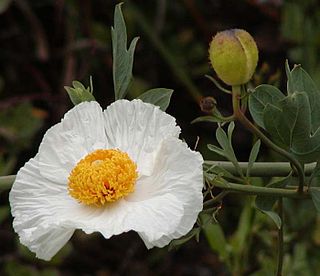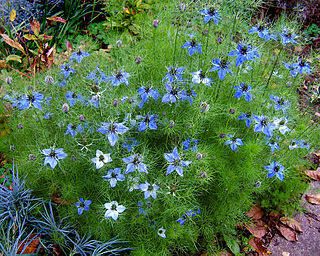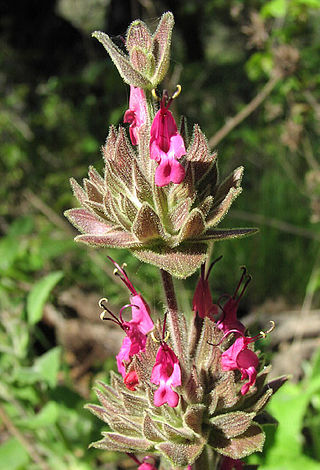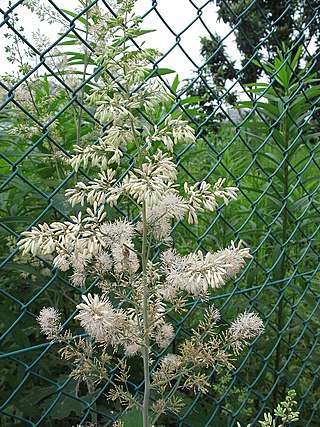
Eschscholzia californica, the California poppy, golden poppy, California sunlight or cup of gold, is a species of flowering plant in the family Papaveraceae, native to the United States and Mexico. It is cultivated as an ornamental plant flowering in summer, with showy cup-shaped flowers in brilliant shades of red, orange and yellow. It is also used as food or a garnish. It became the official state flower of California in 1903.

Coulter pine, or big-cone pine, is a native of the coastal mountains of Southern California in the United States and northern Baja California in Mexico. Isolated groves are found as far north as Clearlake, California on the flanks of Mt. Konocti and Black Diamond Mines Regional Preserve. It is named after Thomas Coulter, an Irish botanist and physician. The Coulter pine produces the heaviest cone of any pine tree, up to 5 kg (11 lb) and among conifers is exceeded only by the cones of Araucaria bidwillii.

Romneya is a genus of flowering plants belonging to the poppy family (Papaveraceae). There are two species in genus Romneya, which was named for Irish astronomer John Thomas Romney Robinson. They are known commonly as Matilija poppies or tree poppies and are native to California and northern Mexico.

Impatiens walleriana, also known as busy Lizzie, balsam, sultana, or simply impatiens, is a species of the genus Impatiens, native to eastern Africa from Kenya to Mozambique. The Latin specific epithet walleriana honours a British missionary, Horace Waller (1833–1896).

Nigella damascena, love-in-a-mist, or devil in the bush, is an annual garden flowering plant, belonging to the buttercup family Ranunculaceae. It is native to southern Europe, north Africa and southwest Asia, where it is found on neglected, damp patches of land.

Hyacinthus orientalis, the common hyacinth, garden hyacinth or Dutch hyacinth, is a species of flowering plant in the family Asparagaceae, subfamily Scilloideae, native to southwestern Asia, southern and central Turkey, northwestern Syria, Lebanon and northern Israel. It was introduced to Europe in the 16th century. It is widely cultivated everywhere in the temperate world for its strongly fragrant flowers which appear exceptionally early in the season, and frequently forced to flower at Christmas time.

Salvia spathacea, the California hummingbird sage or pitcher sage, is a species of flowering plant in the family Lamiaceae, native to southern and central California growing from sea level to 610 m (2,001 ft). This fruity scented sage blooms in March to May with typically dark rose-lilac colored flowers. It is cultivated in gardens for its attractive flowering spikes and pleasant scent.

Sanguinaria canadensis, bloodroot, is a perennial, herbaceous flowering plant native to eastern North America. It is the only species in the genus Sanguinaria, included in the poppy family Papaveraceae, and is most closely related to Eomecon of eastern Asia.

Papaver nudicaule, the Iceland poppy, is a boreal flowering plant. Native to subpolar regions of Asia and North America, and the mountains of Central Asia as well as temperate China, Iceland poppies are hardy but short-lived perennials, often grown as biennials. They yield large, papery, bowl-shaped, lightly fragrant flowers supported by hairy, 1 foot (30 cm) curved stems among feathery blue-green foliage 1-6 inches long. They were first described by botanists in 1759. The wild species blooms in white or yellow, and is hardy from USDA Zones 3a-10b.

Geranium maculatum, the wild geranium, spotted geranium, or wood geranium, is a perennial plant native to woodland in eastern North America, from southern Manitoba and southwestern Quebec south to Alabama and Georgia and west to Oklahoma and South Dakota.

Macleaya, or plume poppy, is a genus of two or three species of flowering plants in the poppy family Papaveraceae, native to Japan and China. They are large rhizomatous herbaceous perennials with palmately lobed, frilly leaves of olive green or grey colour, 25 cm (10 in) long, and tall stems with airy plumes of petal-less, tubular, off-white or cream flowers.

Macleaya cordata, the five-seeded plume-poppy, is a species of flowering plant in the poppy family Papaveraceae, which is used ornamentally. It is native to China and Japan. It is a large herbaceous perennial growing to 2.5 m (8 ft) tall by 1 m (3 ft) or more wide, with olive green leaves and airy panicles of buff-white flowers in summer.

Oenothera lindheimeri, commonly known as Lindheimer's beeblossom, white gaura, pink gaura, Lindheimer's clockweed, and Indian feather, is a species of Oenothera. Several of its common names derive from the genus Gaura, in which this species was formerly placed.

Romneya trichocalyx, the bristly Matilija poppy or hairy Matilija poppy, is a species of flowering plant in the poppy family. This poppy is native to San Diego, Ventura, and Santa Barbara counties in California, as well as Baja California, Mexico, where it grows in dry canyons in chaparral and coastal sage scrub plant communities. Like its relative Romneya coulteri, it is used as an ornamental plant, kept for its large, showy flowers.

Rodgersia podophylla is a species of flowering plant in the saxifrage family native to Japan and Korea. Growing to 2 m (6.6 ft) tall and broad, it is a herbaceous perennial with handsome spiky leaves, and occasional creamy-white flower panicles in June and July. It is extensively grown for ornamental use in gardens where it prefers damp shady positions on neutral to acid soils. Though hardy to −20 °C (−4 °F) it enjoys a sheltered location. It is chosen primarily for its clumps of large 5- or 7-toothed palmate leaves, which open bronze, turning green in summer and bronze-red in autumn. It can spread by underground rhizomes, eventually covering a large area.

Iris pallida, the Dalmatian iris or sweet iris, is a hardy flowering perennial plant of the genus Iris, family Iridaceae. It is native to the Dalmatian coast (Croatia) but widely naturalised elsewhere. It is a member of the subgenus Iris, meaning that it is a bearded iris, and grows from a rhizome.

Hakonechloa is a genus of bunchgrass in the tribe Molinieae of the grass family, Poaceae, native to eastern Asia.

Ipheion uniflorum is a species of flowering plant, related to the onions, so is placed in the allium subfamily (Allioideae) of the Amaryllidaceae. It is known by the common name springstar, or spring starflower. Along with all the species of the genus Ipheion, some sources place it in the genus Tristagma, but research published in 2010 suggested that this is not correct. It is native to Argentina and Uruguay, but is widely cultivated as an ornamental and reportedly naturalized in Great Britain, France, Australia, New Zealand and the United States.

Meconopsis grandis, the Himalayan blue poppy, is a species of flowering plant in the poppy family Papaveraceae, native to China (Yunnan), Bhutan, North East India and Nepal.

Spiranthes odorata, marsh lady's tresses or common lady's tresses, is a species of flowering plant in the orchid family, native to the southeastern United States, from Texas eastwards and northwards to Delaware. It grows in moist, partially shaded environments with acidic or neutral soil.






















